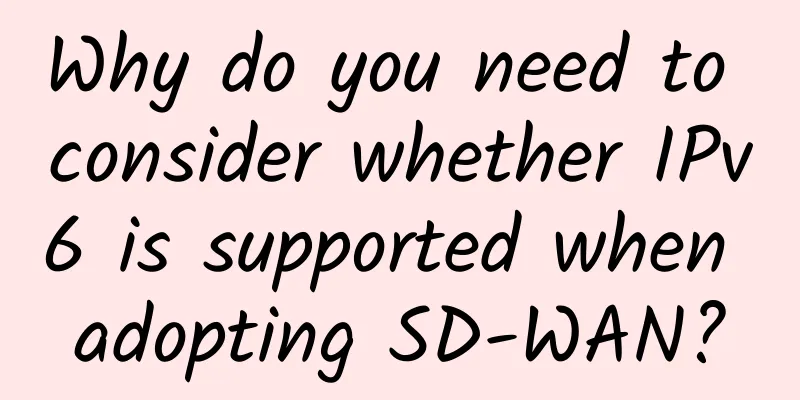Why do you need to consider whether IPv6 is supported when adopting SD-WAN?

|
The Internet of Things (IoT) has fundamentally changed the way we interact with technology. From wearable devices that track our workouts to smart thermostats that help us save energy, no one can deny that IoT helps improve the quality of our lives. In an enterprise setting, IoT helps companies save money and increase productivity by streamlining operations through automation and uncovering new revenue opportunities. Big data analytics, sensors, and specialized applications (all of which are interconnected through various networks) are tools companies are using to harness the power of IoT to their benefit. However, IoT can also be beneficial, and it is undeniable that it is having a profound impact on today’s network infrastructure. Most networks are not designed to support the large volumes of data that come from the myriad of devices that make up an IoT solution. As a result, many businesses are not reaping the full rewards that IoT can offer.
A big part of the problem stems from the current IP standard, IPv4 addresses are close to exhaustion. In some parts of the world, namely the Asia Pacific region, there are no more IPv4 addresses to be obtained. As new devices enter the network, there are not enough public addresses under IPv4. When Vint Cerf and Bob Kahn introduced IPv4 in 1974, the plan was to accommodate about 4.3 billion addresses, which at the time seemed like a sufficient number to justify the protocol for years to come. But what the developers couldn't predict was the explosion of mobile devices and other "always-on" Internet-connected devices, each of which would require its own unique address. The latest standard for the Internet, IPv6, provides more numeric IP addresses. IPv6 also provides simplified address allocation and additional inherent security over IPv4. Adoption of IPv6 is growing. What makes IPv6 so special? IPv6 has many different features from IPv4. For example, it uses 128-bit Internet addresses, which means it can support 2×128 Internet addresses, enough to accommodate many devices for a long time. From a security perspective, IPv6 embeds the use of IPsec (encryption), which can be said to be the level of security you get when IPsec uses IPv4. The main difference is that it is put into IPv6 at a per-packet level. However, the enhancement it provides is the application of cryptography to applications such as the Internet Control Message Protocol (ICMP), because IPv6 supports and is designed (ICMPv6) and ICMPv4, the latter of which is often blocked and can contain malware. More importantly, IPv6 supports the SEND protocol, which authenticates hosts through encrypted information, greatly reducing the possibility of naming-based attacks. In contrast, with IPv4, it is easier for hackers to direct traffic for malicious purposes, such as attacks or espionage. IPv6 configuration is also much simpler. The version's auto-configuration feature allows devices to generate IPv6 addresses instantly, reducing the amount of manpower required to set up the device. IPv6 is great, but can the network handle it? Increasingly, IoT devices will leverage IPv6 to address efficiency, scale, and security issues. For many companies, this boost in IPv6 adoption is a double-edged sword: They now have enough addresses to add IoT devices to their networks, but their existing infrastructure can’t keep up with the bandwidth demands of IoT solutions. In many cases, they’re hampered by networks that suffer from latency issues as they try to accommodate so much data. That’s why software-defined networking, and software-defined wide area networking (SD-WAN) in particular, is an attractive proposition for companies looking to upgrade their existing networks. From optimized application and cloud connectivity to enhanced security, to easier configuration and the ability to support any transport, the benefits of SD-WAN are numerous. SD-WAN provides a pathway for companies that want to move to an infrastructure that is not defined by proprietary hardware and time-consuming configuration, but by simplicity, agility, and flexibility. Importantly, while IPv4 is near exhaustion, it is not dead yet. That is why companies looking to adopt SD-WAN must ensure that the solution they choose supports both IPv4 and IPv6 to ensure a smooth transition to their digital transformation strategy. Without this support, companies may experience many of the same connectivity issues as their current WANs. Clearly, the combination of IPv6 and IoT makes SD-WAN an attractive proposition for enterprises, especially for companies that are already feeling the strain of the deluge of data from multiple devices. Together, these new technologies offer businesses a wealth of opportunities to expand their capabilities and improve their bottom line. |
<<: In simple terms, what exactly is blockchain?
>>: Four trends to watch out for in 2018
Recommend
5G is eating into Wi-Fi traffic
With the commercialization of 5G and the increase...
Six IT trends to watch in 2023
Businesses and society at large continue to turn ...
Are there many pitfalls when porting your number? These users can't even do it
In the week since the black hole photo was releas...
Broadband speed increase is in earnest: starting from 100M in big cities!
The government's plan to increase speed and r...
Research and Markets: Global 5G system integration market size will reach US$45.5 billion in 2027
On April 20, according to foreign media reports, ...
Have you ever thought about why TCP needs to handshake before sending data?
When I look at computer networks, there is always...
Yan Lida, President of Huawei Enterprise BG: Achieving Dreams and Creating Infinite Possibilities
On September 7, the third day of the All-Connect ...
Five-minute technical talk | HTTP evolution history
Part 01 Protocol Introduction HTTP is the most po...
The most anticipated technology trends in 2023
In 2023, technology will further develop, and new...
Screen unlocking technology + 48MP ultra-wide-angle AI triple camera, Huawei Enjoy 10S in-depth review
I don’t know when it started, but when people men...
Take a look at Sigfox, LoRa, and NB-IoT: wireless transmission technologies in the era of the Internet of Things
Wireless communication technology is the transmis...
Cyber Security Awareness Week丨Ruishu Information explains how to ensure data security?
It has been one year since the Data Security Law ...
BuyVM: Starting from $2/month, AMD Ryzen+NVMe+1Gbps unlimited traffic, KVM architecture, Las Vegas/New York/Miami
BuyVM is a foreign hosting company founded in 201...
Aruba Global Research Report Reveals AI Technology Will Become a Powerful Tool to Meet Security Challenges in the IoT Era
On October 26, 2018, Aruba, a Hewlett Packard Ent...
LOCVPS launches 1Gbps port VPS in Hong Kong, 20% discount, monthly payment starts from 36 yuan
LOCVPS launched a 1Gbps port Hong Kong VPS host b...









